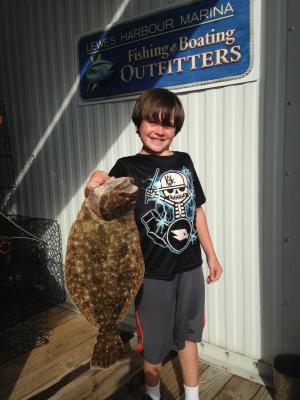Beginning Monday, Aug. 29 and ending Friday, Sept. 30, a lottery will be held for deer hunting on Prime Hook National Wildlife Refuge. Hunters with disabilities will be assigned to the Island Farm Area while all other hunters will be placed in the Headquarters Area. Waterfowl hunters with disabilities can apply for permits to hunt the Island Farm Area from Sept. 1 to Oct. 3. The results of the deer hunting lottery will be announced Monday, Oct. 3, while the waterfowl hunters will be notified Friday, Oct. 7.
To apply for either of these hunts, go to www.primehookpermits.com. Refuge-specific hunting regulations can be obtained at this site or at http://www.fws.gov/refuge/prime hook/. Any questions should be directed to the refuge office at 302-684-8419.
Size matters
Over the past few weeks, I have seen photos of Spanish mackerel and bluefish caught near Fenwick Shoal. Now, I realize it is difficult to judge the size of the fish from a photo, but even with that in mind, the Spanish mackerel in question do not appear to meet the 14-inch minimum size. To the best of my knowledge, no one has been arrested for possession of undersized Spanish mackerel, but if people continue to keep these small fish, sooner or later someone will be checked by a DNREC Enforcement officer and have to pay a hefty fine.
Fishing report
The Delaware Bay continues to produce croaker, kings, blowfish, trout and bluefish. Unfortunately, the vast majority of these fish are small. On the plus side, keeper flounder have been caught at the lower bay reef sites by those willing to sacrifice a few bucktails to the hard structure.
The Outer Wall and the Ice Breakers have seen pretty good fishing for sheepshead. Live sand fleas are the most popular bait with peeler crab or blue crab also accounting for some of these fish.
We had one report of spadefish taken off the Mohawk Wreck on small bits of clam. These can be a very frustrating fish to catch. At times you will see them milling around on the surface and they won’t touch a bait. At other times these same fish will keep rods bent continually.
The best way to fish for them is to anchor up tide from the structure. Begin by putting over a chum pot loaded with the soft parts of chowder or surf clams. Bait small circle hooks with bits of the clam’s foot and let this drift back toward the structure. At times it is a good idea to fish this single hook under a bobber.
Spadefish have a complicated bite. I don’t know exactly what they do, but if you are holding the rod, you will feel a series of taps before the fish takes the bait and moves away. It is pretty hard to resist setting the hook, but if you try you will lose the fish. I have found the most productive technique is to put the rod in a holder and wait until line is coming off the reel before picking it up.
Spades can pull pretty hard and will drag you into the structure if given half a chance. Set a firm drag and use a 15- to 20-pound fluorocarbon leader from the running line to the hook.
I have seen spadefish over reef sites and around the Outer Wall so they are here in good numbers. If you have never caught one, it is a learning process well worth mastering because along with the spirited fight goes some pretty good eating.
Flounder fishing has improved a bit at Indian River Inlet. Drifting from the Coast Guard Station to the entrance to Indian River Marina or from the campgrounds to South Shore Marina has proven to be productive. Jigging a bucktail sweetened with Gulp!, squid or a shiner is doing some of the damage along with a minnow and a strip of squid.
Better flounder fishing has been found in the ocean. Right now the best location is the deeper water around A Buoy. The general consensus is the fish are looking for deeper, cooler water as the temperature climbs. A surprising number of keeper sea bass have been caught along with the flounder.
The tuna chunking bite at the inshore lumps seems to be over. Not to say it couldn’t start again, but more than likely all tuna action will be in the canyons for the rest of the season. Have not seen as many bigeyes as we saw last year, but that could change overnight.
The billfish action has been the center of attention this week. With more than $1 million to be awarded for the largest white marlin caught during the White Marlin Open, not too many folks are fishing for anything else.
























































